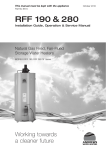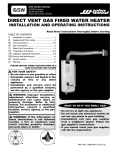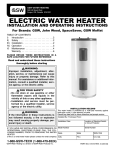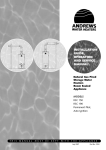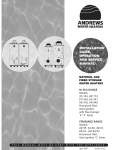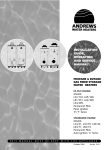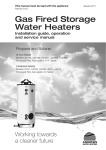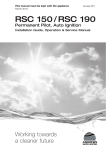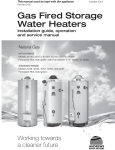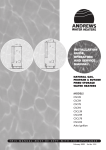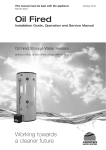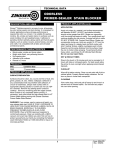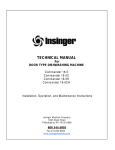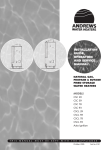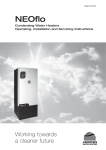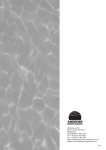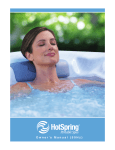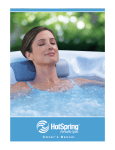Download INSTALLATION GUIDE, OPERATION AND SERVICE MANUAL
Transcript
INSTALLATION GUIDE, OPERATION AND SERVICE MANUAL NATURAL GAS FIRED STORAGE WATER HEATERS Models RFF190 RFF280 ‘B’ Series T H I S M A N U A L M U S T B E K E P T W I T H T H E A P P L I A N C E June 2004 Part No. E515 the nation’s favourite for PLUMBING & HEATING SUPPLIES FREE SHIPPING SECURE PAYMENTS on all orders over £100 to mainland UK shop online with confidence FINANCE AVAILABLE PRICE MATCH spread the cost with low interest rates always get the best deals available we have H U G E R E D U C T I O N S ON THOUSANDS OF ITEMS Boilers Bathroom suites Radiators Kitchen sinks & taps Heating controls Showers Pipes & ittings Wet rooms Cylinders Towel warmers Fires Bathroom furniture Renewable energy & much more visit our website plumbnation.co.uk CALL US ON 0844 800 3460 © Copyright Andrews Water Heaters 2004 Reproduction of any information in this publication by any method is not permitted unless prior written approval has been obtained from Andrews Water Heaters. Andrews Storage Water Heaters have been designed and manufactured to comply with current International standards of safety. In the interests of the health and safety of personnel and the continued safe, reliable operation of the equipment, safe working practices must be employed at all times. The attention of U.K. users is drawn to their responsibilities under the Health and Safety Regulations 1993. All installation and service on the Andrews Water Heater must be carried out by properly qualified personnel, and therefore no liability can be accepted for any damage or malfunction caused as a result of intervention by unauthorised personnel. The Andrews Water Heaters policy is one of continuous product improvement, and therefore the information in this manual, whilst completely up to date at the time of publication, may be subject to revision without prior notice. Further information and assistance can be obtained from: Andrews Water Heaters Wednesbury One, Black Country New Road Wednesbury, West Midlands WS10 7NZ Tel: +44 (0)121 506 7400 Fax: +44 (0)121 506 7401 Email: [email protected] Website: www.andrewswaterheaters.co.uk THE ANDREWS WATER HEATERS COVERED IN THIS MANUAL ARE FOR USE WITH NATURAL GAS ONLY CONTENTS SECTION 1 SECTION 2 PAGE GENERAL AND SAFETY INFORMATION General Information 2 British Standards 2 Health and Safety Regulations 1993 3 Legionellae in Water Heaters 3 TECHNICAL DATA Appliance Dimensions SECTION 3 SECTION 4 SECTION 5 INSTALLATION Location 6 Flue Systems 6 Air Supply 7 Water Quality and Treatment 9 Water Connections 10 Vented Systems 10 Unvented Systems 11 Gas Connection 14 Electrical Supply 14 COMMISSIONING To light the Burner 16 To Shut Off the the Burner Users Safety Guide 16 17 OPERATION To Check Main Burner Pressure SECTION 6 4 18 SERVICING Burner Assembly 19 Gas Control Valve 20 Flue Ways 20 Magnesium Anode(s) 21 Descaling Information 21 SECTION 7 FAULT FINDING 22 SECTION 8 PARTS LISTS AND ILLUSTRATIONS 24 SECTION 1 GENERAL INFORMATION GENERAL AND SAFETY INFORMATION The Andrews Water Heater has been designed for use with NATURAL GAS only and is manufactured to give an efficient, reliable and long service life. To ensure the continued, trouble-free operation of your heater at maximum efficiency, it is essential that correct installation, commissioning, operation and service procedures are carried out strictly in accordance with the instructions given in this manual. By law, installation and commissioning of the heater must be carried out by properly qualified personnel. The The The The heater(s) must be installed in accordance with the following requirements; current GAS SAFETY (INSTALLATION AND USE) REGULATIONS current BUILDING REGULATIONS Water Supply (WATER FITTINGS) REGULATIONS 1999 Additionally, installation should be performed in accordance with all relevant requirements of the Gas Supplier, Local Authority and recommendations of the British Standards and Codes of Practice detailed below. BRITISH STANDARDS AND CODES OF PRACTICE BS 6700: 1997 Specification for design, installation, testing and maintenance of services supplying water for domestic use within buildings and their curtilages. This standard supersedes the following British Standards and Codes of Practice: CP99, CP310, CP324, 202, CP342 Part 2, Centralised Hot Water Supply. BS 5440 Part 1:2000 Part 2:1989 Installation of flues and ventilation for gas appliances of rated output not exceeding 60kW. Specification for installation of flues. Specification for installation of ventilation for gas appliances. BS 5546:1990 Installation of gas hot water supplies for domestic purposes. BS 6891 Installation of low pressure gas pipework of up to 28mm in domestic premises. BS 7206:1990 Specification for unvented hot water storage units and packages. I/M2 I/M5 Purging procedures for non-domestic gas installations. Soundness testing procedures for industrial and commercial gas installations. Flues for commercial and industrial gas fired boilers and air heaters. Notes on installation of gas pipework (excluding 25mm and below). I/M11 I/M16 NOTE: 2 Consideration should be given to amendments or updates to the above standards. GENERAL AND SAFETY INFORMATION It is the duty of manufacturers and suppliers of products for use at work to ensure, so far as is practicable, that such products are safe and without risk to health when properly used and to make available to users, adequate information about their safe and proper operation. Andrews Water Heaters should only be used in the manner and purpose for which they were intended and in accordance with the instructions in this manual. Although the heaters have been manufactured with paramount consideration to safety, certain basic precautions specified in this manual must be taken by the user. SECTION 1 HEALTH AND SAFETY REGULATIONS 1993 It is imperative that all users of the heater must be provided with all the information and instruction necessary to ensure correct and safe operation. Water systems in buildings have been associated with outbreaks of Legionnaires' Disease, particularly in health care facilities where occupants are significantly more susceptible to infection. In recognition of the risks in hospitals, a Code of Practice for the Control of Legionellae in Health Care premises has been issued by the Department of Health (1991). Codes of Practice applicable to other premises have been published by other organisations, principally the Health and Safety Executive (HS)(G70) and the Chartered Institute of Building Services Engineers (C1BSE, TM13). EFFECTIVENESS IN COMBATING LEGIONELLAE All Codes of Practice draw attention to the design and operation of water systems with reference to avoidance of factors that favour colonisation by Legionellae bacteria. These factors include stagnation, lukewarm conditions (20ºC to 45ºC) and the accumulation of debris, scale and corrosion in the base of tanks and calorifiers. Andrews Water Heaters has commissioned an independent evaluation of their products to investigate their resistance to build-up of legionellae bacteria. Experiments were conducted to determine whether, following a substantial challenge by legionellae pneumophilia, after overnight and stagnation conditions, the system was rendered free from viable recoverable legionellae. It was found that at 61ºC, following a challenge of approximately 107 organisms per litre, within one hour, more than 99.999% of organisms had been killed. After a subsequent stagnation period, sampling did not reveal any residual contamination. The design of the base of the water heater precludes legionellae colonisation, even after build-up of debris. The burner positioning ensures that the water at the bottom of the heater reaches the same, or higher temperature as in the rest of the heater. Based on data obtained through experiment, the Andrews Water Heater can be described as legionellae resistant as it is considered unlikely that, at the temperature tested, the organism would colonise the water heater and present a possible health risk. 3 SECTION 2 TECHNICAL DATA RECOMMENDED SERVICE CLEARANCE J H E F B K D RECOMMENDED SERVICE CLEARANCE M L L N O RECOMMENDED SERVICE CLEARANCE RECOMMENDED SERVICE CLEARANCE L C A G Fig 1. MINIMUM SERVICE CLEARANCE APPLIANCE DIMENSIONS 4 MODEL RFF190 RFF280 A mm inches 1448 57 1524 60 B mm inches 158 61⁄4 158 61⁄4 C mm inches 559 22 660 26 D mm inches 279 11 279 11 E mm inches 80 3 80 3 F mm inches 1397 55 1397 55 G mm inches 432 17 490 191⁄4 H mm Min - Max inches Min - Max 150 -300 6 - 12 150 - 300 6 - 12 J mm Min - Max inches Min - Max 483 - 7000 19 - 276 533 - 4000 21 - 156 K mm inches 310 121⁄4 310 121⁄4 L mm inches 305 12 305 12 M mm inches 345 131⁄2 396 151⁄2 N mm inches 275 11 326 13 O mm inches 610 24 610 24 TECHNICAL DATA SECTION 2 ANDREWS MODEL NO. RFF190 RFF280 Storage Capacity litre gallons 190 42 280 62 Recovery thro' 44ºC/80ºF l/h gal/h 291 64 339 75 Recovery thro' 56ºC/100ºF l/h gal/h 232 51 272 60 Heat Input kW (Hs) Btu/hr 19.5 66,534 23 78,476 Gas Flow Rate m3/hr ft3 /hr 1.82 64.3 2.15 76 Flue Gas Temp. (Approx) ºC ºF 70 158 70 158 Flue Gas Volume m3/hr 32 29 Inlet & Flow Connections R R (in BSPT/Ext) 3/4 3/4 3/4 3/4 Return Connection R (in BSP/Int) Rp (in BSP P/Int) 3/4 3/4 3/4 3/4 Weight Empty kg lb 75 165 132 292 Weight Full kg lb 273 603 418 908 Max Working Pressure bar psi 10 150 10 150 Max Test Pressure bar psi 20.6 300 20.6 300 Gas Family 12H (Natural) Gas Connection Rp BSPT 1/2 1/2 1/2 1/2 Burner Pressure mbar wg 10.0 4.0 10.0 4.0 Injector Diameter mm No 3.90 24 4.20 19 Shipping Weight kg lb 84 185 144 317 Shipping Dimension Carton HxWxD mm in 1785 x 600 x 660 70 x 24 x 26 1840 x 680 x 755 72 x 27 x 30 Mains Voltage Frequency 220/240 - IP20 50Hz Power Consumption 236W Fuse 5 amp 5 SECTION 3 INTRODUCTION INSTALLATION THE LAW REQUIRES THAT INSTALLATION IS CARRIED OUT BY A PROPERLY QUALIFIED PERSON Install in accordance with current British Standard Code of Practice 342 part 2 and British Standards 5440, 5546, 6644, 6700, 6798 and 6891. LOCATION The location chosen for the heater must permit the provision of a satisfactory flue and an adequate air supply. The heater must not be installed in a room which contains a bath or a shower and must not be installed in a bedroom or bedsitting room. A clearance of 3OOmm (l2in) should be left around the heater for fitting and servicing purposes and 762mm (3Oin) above the heater for removal of the flue baffle. The above clearances are recommended for ease of servicing. They can be reduced if necessary but a clearance of 3OOmm (12in) must be left in front of heater for access to the burner and controls. The flue baffle clearance should also be maintained if possible to avoid servicing problems. The floor on which the heater is installed must be flat, level and of sufficient strength to withstand the weight of the heater when filled with water, and should satisfy the requirements of the Local Authority & Building Regulations. Any combustible material adjacent to the heater must be so placed or shielded as to ensure that its temperature does not exceed 65ºC (150ºF). FLUE SYSTEM Detailed recommendations for flueing are given in British Gas booklet IM/11 and BS 5440 part 1. The following notes are intended to give general guidance: • Route. The route of the flue is not critical but, when planning horizontal runs, potential condensate traps must be avoided. When calculating maximum flue runs, a reduction must be made of 1 metre run per 90° elbow and a 1/2 metre run per 45° elbow. • Location. The siting of the flue terminal is not critical with respect to the performance of the unit. However, areas where the discharge of combustion products would cause a nuisance should be avoided. In accessible positions a suitable guard should be provided. RFF190 & RFF280 FLUE FITTING INSTRUCTIONS 1. Fit spigot adaptor E4 to heater flue spigot in the direction shown. Note! Fire resistant silicon sealant should be used on this joint. 2. Fit elbow E3 into spigot adaptor E4 for horizontal flue routes or E2 for vertical flue routes. 3. Fit flue pipe into E2 to give required length of flue route. Refer to manual for maximum horizontal and vertical flue routes. 4. Determine correct position and fit outer wall plate using 4 screws and rawplugs provided. Cut flue sleeve to suit wall thickness and fit flue pipe through wall to outer wall plate. Fit inner wall plate and fix using 4 screws and rawplugs provided. 5. The lengths of flue pipe may be cut to obtain correct length of flue route required. 6. On vertical flue installations it is important to fit the correct flue terminal E4 supplied by Andrews Water Heaters. 7. For further information contact Andrews Technical Dept. E5 E3 E2 E4 6 E2 E2 E2 E1 Components supplied in Flue Kit INSTALLATION SECTION 3 (a Max) FLUE SYSTEM Size RFF190 RFF280 a 8m 5m b 7m 4m (b Max) 0.3m Fig 2. Typical Flue Installation Detailed recommendations for air supply are given in BS 5440 part 2. AIR SUPPLY The following notes are intended to give general guidance: Where the heater is to be installed in a room or internal space the heater requires the room or internal space containing it to have a permanent air vent. The vent must be either direct to outside air or to an adjacent room or internal space which must itself have a permanent vent of at least the same size direct to outside air. The minimum effective area of the permanent air vent(s) required is as follows: 5 cm2 per kW in excess of 7 kW Where the heater is to be installed in a compartment, permanent air vents are required in the compartment at high and low level. These air vents must either communicate with a room or internal space or be direct to outside air. The minimum effective areas of the permanent air vents required in the compartment are as follows:- Air Vent Areas Position of Air Vents Air from room or internal space Air direct from outside High Level 10 cm2 per kW 5cm2 per kW Low level 20cm2 per kW 10cm2 per kW 7 SECTION 3 AIR SUPPLY INSTALLATION Note: - Both air vents must communicate with the same room or internal space or must both be on the same wall to outside air. Where compartment air vents are open to a room or internal space, the room or internal space must itself have a permanent air vent(s) as previously specified. For multiple installations where the total heat input exceeds 60 kW (204,720 Btu’s/hr), reference must be made to BS 6644. The table on p7 should be used to calculate requirements. Detailed recommendations are given in BS 6644 Clause 19. The following notes are intended to give general guidance. Ventilation shall prevent the heater environment from exceeding 32°C (90°F). The purpose provided space housing the heater(s) must have permanent air vents communicating directly with the outside air, at high and low level. Where communication with the outside air is possible only by means of high level air vents, ducting down to floor level for the lower vents should be used. For an exposed building, air vents should be fitted preferable on all four sides, but on at least two sides. Air vents should have negligible resistance and must not be sited in any position where they are likely to be easily blocked or flooded or in any position adjacent to an extraction system which is carrying flammable vapour or other contaminated air. IMPORTANT The supply of air to a space housing the heater(s) by mechanical means should be:(a) Mechanical inlet with natural extraction. (b) Mechanical inlet with mechanical extraction. NB - Natural inlet with mechanical extraction must not be used. Where a mechanical inlet and mechanical extraction system is used, the design extraction rate must not exceed one third of the design inlet rate. All mechanical ventilation systems must be fitted with automatic gas shut off safety systems which cut off the supply of gas to the heater(s) in the event of failure of either the inlet or extract fans. NB - The vapours given off by halogen based compounds can, if drawn into the combustion air, cause corrosion of the Storage Vessel and premature failure of the thermocouple. If water heaters are to be installed in locations where halogens are likely to be present they should be isolated from such compounds and ventilated from and to outside, uncontaminated, atmosphere. Some of the vulnerable areas are listed below:(i) Hairdressing salons and adjoining rooms and basements. (ii) Establishments where dry cleaning solutions are used or stored. (iii) De-greasing plants using hydrocarbon solvents. (iv) Premises where refrigerant gases are used or stored. (v) Environments with dust laden atmosphere 8 INSTALLATION SECTION 3 WATER QUALITY AND TREATMENT Where extreme conditions of water hardness exist, scale can form in any water heating equipment, especially when the heater is working under conditions of constant heavy demand and at high temperatures. WATER CONNECTIONS GENERAL Each water heater is fitted with one or more magnesium anode(s) which protect the tank from corrosion caused by electrolytic action. Magnesium anodes are sacrificial in that they corrode as they protect. When the anode has eroded to less than 50% of it's original diameter, it may not offer protection.The anodes should be inspected annually and replaced as necessary. Frequency of anode replacement will vary dependent on water quality. Andrews Water Heaters offer CorrexTM UP powered anodes as an alternative to the standard magnesium anodes. These anodes do not need maintenance or replacement. The potentiostat which regulates the current to the CorrexTM anode, features an indicator light which shows green to indicate correct function and red to indicate malfunction. These anodes are available as an optional extra on all Andrews heaters. In hard water areas, scale formation can occur in hot water systems and hot water heaters and the higher the temperature and volume of water used, the more problematic the scale build-up can be. Water treatment is normally recommended when the hardness reaches 100 - 150ppm (7 - 10 degrees Clark) and above. This problem can be minimised by reducing the water temperature in the heater and by fitting suitable water pretreatment equipment. When installing Andrews Water Heaters in hard water areas we would recommend that a water treatment specialist is consulted. HYDROJET SYSTEM How the system works The upper “jet ports” direct the flow outward to begin the dynamic mixing action. The lower “jet ports” direct the flow inward to increase the turbulence. The heater is fitted with the Hydrojet Total Performance System incorporated in the cold inlet dip tube. The tube is designed to increase turbulence and reduce sediment build up, reduce thermal stacking and increase delivery. 9 SECTION 3 WATER CONNECTIONS VENTED SYSTEMS INSTALLATION The water heater must be supplied from a cold water feed cistern and the hot water supply pipe must be fitted with an open vent pipe in accordance with BS 5546. Local regulations and bye-laws must be observed when installing the system but typical water service layouts are shown in Figs. 3 and 6. The cold water feed cistern must have an actual capacity greater than the hourly recovery rate of the heater or heaters to which it is fitted, the minimum actual capacity allowed for a feed cistern is 227 litres (50 gall). The actual cistern capacity is the capacity to the normal water line of the cistern. All cisterns used should be to the relevant British Standard and the distance from the normal water line to the top of the cistern should be as laid down by the water authorities. The cold water inlet and hot water outlet are identified on top of the heater. Connect the cold water feed and hot water outlet to these nipples with union adaptors for ease of servicing. (See Servicing Section 6). CAUTION - DO NOT APPLY HEAT TO THESE NIPPLES IF MAKING CAPILLARY SOLDERED JOINTS AS THEY ARE FITTED WITH PLASTIC INSERTS. MAKE THE CAPILLARY JOINTS TO THE PIPES BEFORE CONNECTING TO THE HEATER. A DRAIN COCK IS SUPPLIED WITH THE HEATER AND THIS SHOULD BE FITTED TO THE APPROPRIATE BOSS AS SHOWN ON THE DRAWING. After installation of the water system open the main water supply valve, flush the system and fill the heater. Open the hot taps to allow air to escape from the system. When the system is free of air, close the taps and check for leaks at the gas control thermostat, drain cock and pipe connections at the top of the heater. Open Vent Stop Valve Cold Water Feed Overflow Cold Water Cistern Hot Water Service Pipe Cold Water Inlet Valve Flue Union Adaptor Gas Cock Gas Control Gas Supply Pipe Thermostat Drain Cock Fig 3. 10 Check Valve Secondary return via Tee in Drain Port INSTALLATION Unvented Systems should be fitted by an Approved Installer. When used in an unvented system, the Andrews Water Heater will supply hot water at a pressure of 3.5bar (50.8lbf/in2) provided that this pressure is available at the mains feed. During conditions of no-flow, system pressure may rise to a maximum of 6bar (87lbf/in2) whilst the burner is operating. When testing the system, it is recommended that a maximum test pressure of 8.62bar (125lbf/in2) is employed. SECTION 3 WATER CONNECTIONS UNVENTED SYSTEMS The heater can be used on unvented hot water storage systems, with the addition of an Unvented Systems Kit, part number B171 available from Andrews Water Heaters. All fittings and materials must be suitable for use with drinking water and listed in the current Water Research Centre "Materials and Fittings Directory". Installation of unvented hot storage water systems must comply with Part G of Schedule 1 of the Current Building Regulations. Fig.4 p12 lists and illustrates the component parts of the Unvented Systems Kit. Fig.5 p13 illustrates the general arrangement of the components. The Wall Mounting Kit is available as an optional extra. Items D4/D6 must be fitted into the Temperature Relief port (see Fig.6, p13). When assembling items D1 and D2 care must be taken to ensure that the flow arrows marked on the components are pointing in the direction of flow i.e. towards the water heater. The cold water for services may be drawn from the 22mm compression port on item D1(a). The water pressure at this point will be similar to that available at the hot water outlet of the water heater. If port (a) is not used it should be sealed with the blanking plug supplied. If higher flow rates are required for the cold water services a suitable “tee” fitting should be included in the pipework upstream of item D1. The pipework fitted to both tundish outlets should be at least 28mm diameter and should be terminated at a suitable drain (see Current Building Regulations Approved Document G3). 11 SECTION 3 INSTALLATION Unvented Systems Kit Fig 4. Unvented Systems Kit Ref. D1 D2 D3 D4 D5 D6 D7 D8 12 Part No. Description Qty B171 C780 C781 C782 E462 C783 C772 B173 C788 C787 Unvented Systems Kit Complete Pressure Reducing Valve/Strainer Check Valve / Expansion Vessel Expansion Vessel Temperature/Pressure Relief Valve Tundish Adaptor Wall Mounting Kit for Expansion Vessel Hose Assembly Wall Bracket Assembly 1 1 1 1 1 1 1 1 1 INSTALLATION SECTION 3 Fig 5. D3 D1 Hot Water Service Pipe Cold Water Take Off D6 D2 D4 D5 Check Valve Secondary return via Tee in Drain Port Cold Water Inlet Fig 6. 13 SECTION 3 GAS CONNECTIONS INSTALLATION THE APPLIANCE MUST ONLY BE USED WITH NATURAL GAS. The installation of the gas supply should conform to the requirements of IM/16 published by British Gas p.l.c. or BS 6891. Jointing compound used must conform to BS 5292 pt 5. CAUTION - DO NOT APPLY HEAT IN CLOSE PROXIMITY TO THE GAS CONTROL AS THIS WILL RESULT IN DAMAGE OCCURRING TO THE CONTROL. Fit the 1⁄2 m/f elbow into the gas control valve. Fit the 1⁄2 gas supply cock immediately upstream of the gas control and elbow and connect to the gas supply. Pressure test the gas installation for soundness. If any doubt exists as to size of gas supply pipe, consult your local Gas Region. It is recommended that a pressure test point is fitted on the input next to the gas supply valve. ELECTRICAL SUPPLY The method of connection to the mains electricity supply should facilitate complete electrical isolation of the appliance preferably by use of an unswitched fused spur. Alternatively, a fused double pole switch or fused spur box, serving only the heater, may be used. A 3mm separation is required between each pole. The point of connection to the mains should be readily accessible and adjacent to the appliance. Wiring external to the water heater must be installed in accordance with the I.E.E. Regulations for the wiring of buildings and to any local regulations that may apply. The Heater is designed to run off a permanent 220/240V 1 Ph 50 Hz supply and the fuse rating is 5 Amp. Important Note If the electrical power supply cable needs to be replaced it must be purchased from the heater manufacturer. 14 INSTALLATION SECTION 3 Fig 7. WARNING DO NOT SWITCH OFF HEATER ELECTRICAL SUPPLY UNLESS CARRYING OUT MAINTENANCE 15 SECTION 4 COMMISSIONING CAUTION: DO NOT OPERATE THE WATER HEATER UNTIL THE STORAGE VESSEL IS COMPLETELY FILLED WITH WATER, WITH WATER RUNNING FROM ALL HOT TAPS. Open the main gas supply valve after all connections to the gas control valve are complete, and test all connections with soap solution. Lighting the burner RESET Temperature Dial VERY HOT LOW HOT Thermostat Setting Approx Water Temperature LOW 108ºF HOT 42ºC 130ºF VERY HOT 54ºC 156ºF 69ºC Fig 8. 1. Set thermostat temperature dial to the desired position. Remove the thermostat cover on the right hand side of the gas control valve. The thermostat can now be adjusted to the required temperature. (See above). Replace thermostat cover. Note: Before adjusting thermostat ensure electrical supply is switched off. 2. Ensure gas supply is on. 3. Ensure electrical supply is on. 4. Ensure time switch, if fitted is in the on position. 5. If the burner does not light the red alarm lamp will illuminate on the gas control panel. Wait a few seconds and press the reset button (See fig 9). The burner should now light. Shutting off burner To shut off the burner isolate the electrical supply, then shut off the gas service cock. The water heater should only be turned OFF for long periods, eg holidays, or in an emergency. Otherwise the heater should be left to operate under normal thermostat control. NB. When using a time control ensure the heater is not turned OFF before the final water draw off occurs. This will ensure the water in the tank is left in a hot condition. 16 COMMISSIONING For your safety read before lighting the appliance WARNING 1. Always follow manufacturers instructions when lighting the appliance. Failure to do so may result in damage to property, personal injury or loss of life. SECTION 4 USERS SAFETY GUIDE 2. Before lighting check all round the appliance area for gas. 3. Do not make any attempt to re-light the appliance if the main burner has extinguished. Wait at least 5 minutes to allow for any unburnt gas to disperse. Ventilate the area if possible. FOR YOUR SAFETY IF YOU SMELL GAS 1. Turn off gas supply and open windows. 2. Do not operate electrical switches. 3. Extinguish any naked flames. 4. Contact gas supplier if the smell of gas persists. FOR YOUR SAFETY Do not store or use petrol, aerosol or other flammable vapours or liquids in the vicinity of this or any other atmospheric gas appliance. WARNING Hotter water increases the risk of scalding. Before changing the temperature refer to instruction manual or data label. Hot water can produce third-degree burns in: 6 seconds at 140ºF (60°C) 30 seconds at 130°F (54°C) 17 SECTION 5 OPERATION Checking main burner pressure BURNER ASSEMBLY 1. 2. 3. 4. Turn gas supply OFF. Release bleed screw A and connect pressure gauge tube (See Fig. 9) Light burner as described previously. Remove cap from port B and adjust pressure using exposed screw in accordance with data plate (See Fig. 9) 5. Shut OFF burner as described previously. Remove pressure gauge tube and tighten bleed screw A. 6. Re-light burner as described previously. Alarm A Reset Button B Fig 9. When properly installed and adjusted the Heater will require the minimum of attention. Should it become necessary to completely drain the heater, close the cold water inlet valve, open a hot water tap to allow air to enter the system. Fit a suitable hose to the drain cock and open. Whenever the Heater is filled with cold water condensation will form on the cold storage vessel surfaces when the burner is lit. Condensation is normal and does not indicate a leak. It will disappear when the storage vessel becomes heated. The control thermostat fitted to this heater has a built in limit thermostat (ECO). In the event of high water temperature the gas supply will be shut off automatically. The high temperature condition must be identified and rectified before the heater is relit. The thermostat has a manual reset button which is pressed to close the ECO and allow the heater to be relit. IF IN DOUBT CONTACT ANDREWS WATER HEATERS 18 SERVICING Whilst giving the following instructions for the care of the Andrews Water Heater, we would recommend that an arrangement is made with your local gas region or installer to carry out periodic checks of the appliance to ensure trouble free operation and continued satisfaction. SECTION 6 BURNER ASSEMBLY The burner assembly should be cleaned and checked annually as follows:1. Move the gas service cock to "OFF". Isolate from the electrical supply. Unhook and remove the outer door. Remove inner door by sliding it to the side on the RFF190 model, or by removing two screws on the RFF280 model. 2. Disconnect from the bottom of the gas control valve, the pilot tube, thermocouple, bleedline and main burner supply tube. Withdraw the burner assembly from the heater complete with blue ignition lead, disconnect from gas control panel. 3. Remove the screw securing the pilot assembly to the main burner supply tube. 4. Remove the gland nut connecting the pilot tube to the pilot assembly. Withdraw the pilot tube and remove the pilot restrictor from the end. Clean the pilot restrictor and blow through the pilot burner with compressed air. 5. Remove the main burner pipe jet assembly from the burner by rotating jet anticlockwise, remove jet and clean. Blow through the main burner with compressed air. DO NOT ATTEMPT TO CLEAN ORIFICES WITH SHARP METALLIC OBJECTS, IF NECESSARY, USE A WOOD SPLINTER TO CLEAR. 6. Re-assemble in the reverse order of steps 2 to 5 but note: i) 7. Be sure to engage the rear pins of the main burner on the RFF280 model or the flattened flange of the main burner supply tube on the RFF190 model into their proper locations in the bracket on the base pan of the heater. Re-light and carry out commissioning check as pages 16 and 17. 19 SECTION 6 SERVICING This should be checked and serviced by an engineer fully conversant with every aspect of this piece of equipment. To change the gas valve it is not necessary to drain down the water heater. See below Retaining screws GAS CONTROL VALVE Gas control bracket To remove gas control, unscrew four retaining screws at top and bottom of gas control bracket. Also it will be necessary to remove gas fittings at the top of the gas valve and the bottom of the gas valve. It is now possible to slide the gas control valve away from the gas valve retaining bracket. Fig 10. Retaining screws 1. Move the gas control knob to "OFF". Isolate from the electrical supply. Unhook and remove the outer door and remove the inner door by sliding to the side on the RFF190 model, or by removing two screws on the RFF280 model. 2. Disconnect burner gas tube, pilot tube and blue ignition lead at gas control. 3. Remove burner assembly complete with pipes and blue ignition lead. 4. Disconnect electrical connection from the top of the heater. Remove the screws that hold the flue-fan in place and remove the flue fan. 5. Withdraw the flue baffle. 6. Clean the flueway with a brush and clean any deposit from the underside of the storage vessel bottom and from the flue baffle. 7. Re-assemble in the reverse order. IT IS IMPORTANT THAT THE BURNER IS CORRECTLY LOCATED IN THE BURNER SUPPORT BRACKET ON BASE OF COMBUSTION CHAMBER. 8. 20 Re-light and carry out commissioning check as pages 16 and 17. SERVICING A magnesium sacrificial anode is fitted in the water storage vessel. The function of the anode is to provide additional protection, against corrosion, for the inside of the vessel. The condition of the anode should be checked regularly and replaced. In order to remove the anode close the cold water feed stop valve, open a hot water tap and, by opening the water heater drain valve, drain off sufficient water to clear the top of the vessel. The anode/outlet nipple can then be unscrewed from the top of the heater. SECTION 6 MAGNESIUM ANODE The original diameter of the anode is 22mm (7⁄8”). If, at any point along its length, the anode is eroded to half, or less, of the original diameter is should be replaced with new. Particular attention should be paid to the extreme ends. If the anode is encrusted with limescale it should be either cleaned or replaced. Where Correx Anodes are fitted no Anode maintenance is required. When descaling the storage water heater your attention is drawn to the following guidelines. SAFETY FIRST - DUE TO THE CORROSIVE NATURE OF THE DESCALE FLUID IT IS ESSENTIAL THAT SUITABLE PROTECTIVE CLOTHING EQUIPMENT IS USED AND ADEQUATE VENTILATION IS AVAILABLE WHEN DESCALING. IT IS IMPORTANT TO FOLLOW DESCALING MANUFACTURES INSTRUCTIONS BEFORE AND DURING USE. 1. Turn gas control on water heater to ‘OFF position and isolate the gas supply. 2. Close water inlet valve and drain heater tank. 3. Remove magnesium sacrificial anode. DESCALING INFORMATION Note: It is recommended that a new anode is fitted. 4. Add suitable hydrochloric based descale acid, the requirement is normally 5 litres for dependent on the amount of limescale present. 5. After a minimum of one hour restore gas supply and turn on main gas burner for 2 minutes (MAXIMUM). 6. Isolate gas supply and drain off descale fluid through drain port. 7. Open cold water feed valve and fill heater tank. 8. Drain and flush out heater for minimum of 30 minutes. 9. Replace anode. 10. Restore gas supply and re-light heater. 21 SECTION 7 FAULT FINDING FAULT 22 ACTION NO IGNITION AT PILOT (a) Power to unit interrupted (b) Thermostat faulty (c) Spark ignition control module faulty FLUE FAN RUNS NO IGNITION SPARK (a) Faulty air pressure switch (b) Faulty spark ignition lead FLUE FAN DOES NOT RUN (a) Power to unit interrupted (b) Faulty fan motor (c) Flue fan ECO actuated CONTINUOUS IGNITION NO PILOT FLAME (a) Check gas service cock is open HEATER WILL NOT LIGHT LOCKOUT ALARM ILLUMINATED (a) Check gas service cock is open Press reset button Check action of flue fan ECO. If this switch is Actuating check: MAIN BURNER OUTAGE AT PERIODIC INTERVALS (a) Sufficient ventilation is provided (b) The resistance of the flue system is to high (c) The burner pressure is to high (d) The flue fan ECO is faulty FAULT FINDING FAULT SECTION 7 ACTION WATER TEMPERATURE TOO HIGH (a) Reset thermostat to lower temperature. (b) Thermostat faulty. Check and replace if necessary. (c) Main gas valve not closing. Clean or replace. WATER TEMPERATURE TOO LOW (a) Reset thermostat to higher temperature. (b) Check gas pressures at burner and at gas inlet to heater. (c) Thermostat faulty. Check and replace if necessary. NOT ENOUGH HOT WATER (a) Check gas pressures at burner and at gas inlet to heater. (b) Check amount of water being used against recovery rate given on data plate. If usage too high, more heating capacity needed. WATER DRIPPING FROM BASE OF HEATER (a) Check if this stops when water in heater is hot. If yes, then condensation is the problem caused by incorrectly designed flue or by tank cooling excessively, i.e. more hot water being used than recovery rate of heater. If so, more heating capacity needed. (b) If water continues to drip when heater is hot, problem is leaking joint or storage vessel. RUMBLING NOISE (a) Scale formation in heater, consult water treatment specialist. Heater must be descaled and suitable water treatment provided to avoid re-occurrence. 23 SECTION 8 PARTS LIST RFF190 & RFF280 C1 C3 A2 A1 C2 B12 B7 B5 B10 B8 A9 A6 B4 B2 B11 B3 B6 B1 B9 A3 A5 A4 A7 A8 A7 A8 E5 E3 E2 E4 24 E2 E2 E2 E1 PARTS LIST RFF190 & RFF280 Model Ref. RFF190 SECTION 8 RFF280 Part Numbers Description Qty A1 E163 E164 Hot Outlet Nipple/Anode 1 A2 E165 E166 Hydrojet Cold Inlet Diptube 1 A3 C247 C247 3/4NPT x 3/4 BSP Nipple 1 A4 C103 C103 Socket Coupler 1 A5 C381 C381 Drain Cock 1 A6 E533 E533 Flue Baffle 1 A7 E168 C660 Cover, Combustion Chamber 1 A8 E169 C329 Cover, Burner Access 1 A9 E501 E501 Thermostat Cover Access 1 B1 E502 E503 Burner Assembly 1 B2 E504 E504 Pilot Supply Pipe 1 B3 E174 E530 Burner Supply Pipe 1 B4 E353 E353 Burner Head 1 B5 E505 E505 Gas Control Valve B6 E531 E532 Injector 1 B7 C382 C382 Gas Cock 1 B8 E506 E506 Spark Ignition Control 1 B9 E507 E507 Pilot Burner Jet N18 1 B10 E508 E508 Pilot Assembly 1 B11 E509 E509 Thermostat 1 B12 E561 E561 1/2” BSP M/F Elbow 1 C1 E510 E511 Flue Fan Assembly 1 C2 E512 E513 Air Pressure Switch 1 C3 E554 E554 Flue Fan ECO 1 Ref. ANDREWS Part Numbers B176 Description Qty Flue Terminal Assembly 1 Comprises E1 C791 Wall Outlet Terminal (includes flue sleeve) 1 E2 E361 Flue 500mm x 80mm ø 4 E3 C792 Elbow 90º 1 E4 C790 Adaptor 1 Optional Extras E5 C794 E045 C793 Elbow 45º (Not Shown) Flue Terminal Flue 1000mm x 80mm ø NOTE: Extra elbows and flue lengths can be ordered as required. Flue terminal is only used on vertical flue installations. 25 Notes 26 Wednesbury One, Black Country New Road Wednesbury, West Midlands WS10 7NZ Tel: +44 (0)121 506 7400 Fax: +44 (0)121 506 7401 Email: [email protected] Website: www.andrewswaterheaters.co.uk 06/04

































